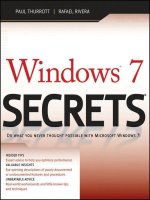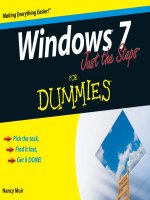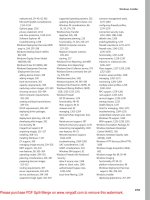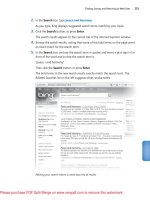Tài liệu Windows 7 Resource Kit- P36 doc
Bạn đang xem bản rút gọn của tài liệu. Xem và tải ngay bản đầy đủ của tài liệu tại đây (2.68 MB, 10 trang )
1703
Windows Installer
malware and, 39–40, 42, 902
Microsoft SpyNet considerations,
1153–1154
Options page, 1156
privacy statement, 1154
real-time protection, 1150–1152
Software Explorer, 48
troubleshooting, 1158
Windows Deployment Services MMC
snap-in, 294, 297–298
Windows Desktop Search (WDS),
822, 829
Windows Display Driver Model
(WDDM), 681
Windows Driver Kit (WDK), 693
Windows Deployment Services
(Deployment Services)
adding device drivers, 198
adding images, 290
boot environment, 303
capacity requirements, 308
capturing custom images, 327–329
choosing versions, 302–304
client computer requirements,
305–306
creating multicast transmissions,
329–331
DCHP requirements, 306–307
deploying driver packages,
317–323
deployment planning, 129–130
developing disk images, 182
functionality, 98
ImageX tool support, 87
importing images, 315–317
installing, 308–311
installing Windows 7, 327
LTI support, 360
managing image security, 324–326
MDT support, 331–332
new features, 98, 303–304
operating modes, 299–301
planning considerations, 301–307
preparing discover images,
313–315
routing requirements, 307
server requirements, 304–305
service architecture, 294–299
supported image types, 302–303
supported operating systems, 302
updating deployment shares, 211
Windows PE considerations, 86,
91, 95, 274, 276
Windows Easy Transfer
depicted, 226, 228
deployment planning, 126
functionality, 27, 224, 226–227
Refresh Computer scenario,
227–229
Replace Computer scenario,
229–230
starting, 227
Windows Error Reporting. See WER
(Windows Error Reporting)
Windows Event Collector service, 973
Windows Events command-line util-
ity, 978–979
Windows executive, 1431
Windows Explorer, 99, 593–595
Windows File Protection (WFP), 54
Windows Filtering Platform (WFP),
1228, 1231–1233, 1291
Windows Firewall
AD DS domains, 1174
functionality, 48–49
IPsec support, 49, 51
malware and, 42
managing, 1263–1264
Microsoft IPsec Diagnostic Tool,
389
Netsh.exe tool support, 387
Network Discovery support, 1170
networking manageability, 1183
new features, 49–51
Remote Assistance support,
1044–1045
troubleshooting, 1584–1585
UAC considerations, 1142
VAMT considerations, 344
Windows SIM support, 92
Windows Firewall with Advanced
Security
allow if secure rules, 1248
allow vs. block rules, 1248
authenticated bypass rules,
1249–1250
boot-time filtering, 1234
common management tasks,
1272–1284
configuring firewall profiles,
1274–1276
connection security rules,
1252–1260, 1281–1282
default rules, 1260
enabling/disabling, 1273
firewall coexistence, 1273–1274
firewall rules, 1245–1252,
1276–1278
functionality, 1227–1228
improvements, 1228–1230
inbound vs. outbound rules,
1246–1247
IPsec support, 1227–1228, 1248,
1252–1260
location-aware profiles, 1228
managing, 1262–1272
monitoring, 1283–1284
multiple active profiles, 1229,
1240–1244
RPC support, 1279–1281
rule support, 1245–1261
service triggers, 1238–1240
startup process, 1233
stealth feature, 1237
tools for managing, 1262–1272
troubleshooting, 1284–1291
unidentified networks and, 1244
Windows PE support, 1260
WSH support, 1235–1238, 1261
Windows Foundation Package, 92
Windows Hardware Developer
Central (WHDC), 766
Windows Hardware Quality Labs
(WHQL), 1509
Windows HTTP Services (WinHTTP),
1096
Windows Image Acquisition (WIA),
682
Windows image file, 89, 93–94
Windows Imaging
functionality, 87, 90–91
platform interconnection, 89
Windows Deployment Services
support, 294, 299, 302
Windows Installer
deploying applications, 257–259
Please purchase PDF Split-Merge on www.verypdf.com to remove this watermark.
1704
Windows Internet Explorer
repackaging limitations, 262
Windows PE considerations, 278,
280
Windows Internet Explorer. See
Internet Explorer
Windows Internet Naming Service.
See WINS (Windows Internet
Naming Service)
Windows Key, 8
Windows Live OneCare, 1162
Windows Management Instrumenta-
tion. See WMI (Windows Manage-
ment Instrumentation)
Windows Management Instrumenta-
tion Command-line (WMIC), 385
Windows Media Device Manager
(WMDM), 682
Windows Media Player Jump List, 6
Windows Memory Diagnostics
configuring, 1498–1499
detecting problems, 1496
functionality, 1479
memory failure, 1494
scheduling, 1496
starting, 1497–1498
Windows Metadata and Internet
Services (WMIS), 708
Windows Mobile Broadband Driver
Model, 682
Windows Network Diagnostics, 1524,
1559–1560
Windows NT Backup-Restore utility,
389
Windows on Windows 32 subsystem,
278
Windows PE (Preinstallation
Environment)
adding device drivers, 284
adding packages, 282–284
additional information, 95
automating, 289–290
capabilities, 275–277
committing changes, 285
configuring build environment,
280
copying applications, 284
creating bootable media, 285–288
creating build environment,
314–315
customizing, 288–289
deployment process overview, 107
Drvload tool support, 97
functionality, 27, 86, 95, 274
installing updates, 284
limitations, 96, 277–278
LTI deployments, 365
MDT support, 86, 95, 273, 291, 331
mounting, 282
new features, 278–279
platform interconnection, 90
removing build environment, 281
ScanState command, 225
setting up environment, 279–281
System Recovery tool support,
1423
updating deployment shares,
210–216
USMT support, 237
Windows AIK 2.0 support, 26,
279–280
Windows Deployment Services
support, 298–300, 308, 360
Windows Firewall support, 1260
Windows Imaging support, 91
Wpeinit tool support, 97
Wpeutil tool support, 97
Windows Peer-to-Peer Networking,
1206–1207
Windows Performance Tools (WPT)
Kit, 963–964
Windows Portable Devices (WPD),
682
Windows PowerShell
additional information, 385
AppLocker support, 1149
command output, 407
defined, 21
downloading, 133
event monitoring support,
979–982
execution policy, 424
functionality, 21, 385, 396
Group Policy support, 384
ISE support, 21, 385
managing BITS, 1093–1094
manipulating GPOs, 508–510
-match operator, 406
MDT requirements, 133
monitoring reliability, 1478
Performance Monitor support,
954–955
pipeline support, 405–416
Remote Desktop support, 388
Windows Troubleshooting
Platform, 23
WMI support, 385
Windows PowerShell cmdlets.
See cmdlets
Windows PowerShell modules.
See modules
Windows PowerShell scripts. See also
functions
additional information, 385
break statement, 443
controlling matching behavior,
451–452
default statement, 449
do...until statement, 434–438
do...while statement, 432–434
enabling support, 423–425
evaluating arrays, 451
exit statement, 444
expanding strings, 428
expressions and paths, 422
for statement, 438–444
foreach statement, 441–443
functionality, 385, 421
if statement, 406, 445–448
literal strings, 429–430
running, 421–423
scripting fundamentals, 421–427
switch statement, 448–452
transitioning from command line,
425–427
while statement, 427–431
Windows Presentation Foundation
(WPF), 765
Windows Quality Online Services
(Winqual), 708
Windows ReadyBoost, 639–641
Windows Recovery Environment.
See WinRE (Windows Recovery
Environment)
Windows Remote Management.
See WinRM (Windows Remote
Management)
Windows Remote Shell (WinRS), 386
Please purchase PDF Split-Merge on www.verypdf.com to remove this watermark.
1705
Wireless Diagnostics
Windows Resource Protection (WRP),
53–54, 141, 680
Windows Script Host. See WSH
(Windows Script Host)
Windows Search feature. See search
capability
Windows Server. See also manage-
ment tools
activation threshold, 339
configuring Offline Files, 597–598
DirectAccess support, 1303
GPMC support, 384
Group Policy support, 484–488
KMS support, 341
operating modes, 299–301
preferred boot behavior, 298
server requirements, 304–305
SMB support, 1202
VPN Reconnect, 1297
WDSSIPR provider support, 297
Windows Deployment Services
support, 293, 302–303, 308–311
Windows PowerShell support, 385
Windows Server Update Services.
See WSUS (Windows Server Update
Services)
Windows Service Hardening. See
WSH (Windows Service Hardening)
Windows Servicing installer, 141
Windows Setup
additional information, 103
answer files, 87, 91
configuration pass, 88
deployment process overview,
106, 234
destination computers, 88
developing disk images, 219
functionality, 86, 93–94
ImageX tool support, 87
Online Configuration phase,
103–104
Preinstallation phase, 102–103
process overview, 101–102
Specialize pass, 104
Windows Deployment Services
support, 298
Windows PE support, 86, 91, 95,
276
Windows Welcome phase, 104
Windows Shutdown Performance
Diagnostics, 1425
Windows SIM (System Image
Manager)
answer files, 87, 91–92
automating settings, 299
catalog files, 88, 289
deployment process overview, 106
functionality, 86, 92–94
package support, 92
platform interconnection, 90
Windows Sockets Direct (WSD), 1209
Windows Sysinternals Suite, 389–390
Windows System Assessment Tool.
See WinSAT tool
Windows Troubleshooting Platform
built-in troubleshooting packs,
1474–1475
components supported, 1475–1476
creating custom troubleshooting
packs, 1476
functionality, 22–23, 880–882,
1474
running troubleshooting packs
remotely, 1476–1477
System Event log, 1526
Windows Update
Action Center support, 12
advantages/disadvantages, 1080
behavior on new computers, 1087
configuring for proxy servers,
1096
device installation enhancements,
697–699
enhancements, 681
extending Point and Print,
805–806
functionality, 1081–1082
Group Policy settings, 1094–1096
installing printer drivers, 764
troubleshooting, 1102–1103
Windows Update Standalone
Installer, 1086
Windows Welcome
improvements, 94
overview, 86
Sysprep support, 94, 104
Windows XP Mode, 144
WindowsInfo.xml file, 708
WinHTTP (Windows HTTP Services),
1096
Winpe.wim command, 282
Winpeshl tool, 97, 277, 288
Winqual (Windows Quality Online
Services), 708
WinRE (Windows Recovery
Environment)
functionality, 25
Recovery Console equivalents,
1452
Startup Repair tool, 1419
System Recovery tool, 1423–1424
Windows PE support, 285
WinRM (Windows Remote
Management)
event collecting support, 973
functionality, 386
WMI support, 384
workgroup environments, 975
WinRS (Windows Remote Shell), 386
WINS (Windows Internet Naming
Service)
deploying applications, 248
developing disk images, 182
DHCP support, 1216
NetBIOS support, 1528–1529
testing application compatibility,
171
WinSAT tool
assessment tests supported, 1010
data files, 1009
exit values, 1011–1012
Features assessment, 1010–1011
functionality, 681, 1009
OEM Upsell And Help section,
1015
OOBE considerations, 1012–1013
Performance Information And
Tools, 1013–1015
running from command line, 1011
System Capability section, 1015
System Performance Rating
number, 1016
troubleshooting device installation,
720–721
Winternals Software LP, 389
Wired Equivalent Privacy (WEP), 1213
Wireless Diagnostics, 1526
Please purchase PDF Split-Merge on www.verypdf.com to remove this watermark.
1706
Wireless Multimedia (WMM)
Wireless Multimedia (WMM), 1178
wireless network adapters, 735–736
wireless networking
configuring settings, 1210–1215
connection considerations, 1308
core improvements, 1203–1205
multiple active firewall profiles, 67
Single Sign-On, 1204
troubleshooting, 1205, 1582–1584
View Available Networks feature,
1211–1212
Wise Installation System (legacy),
257, 261
Wise Package Studio, 264
WLAN AutoConfig service, 1204,
1211
WMDM (Windows Media Device
Manager), 682
WMI (Windows Management
Instrumentation)
additional information, 385
configuring power management
settings, 748
filtering support, 209–210
functionality, 384–385
Group Policy preferences and, 19
moving user profiles, 546
VAMT support, 344
Windows PE support, 95
WMIC (Windows Management
Instrumentation Command-line),
385
WMIS (Windows Metadata and
Internet Services), 708
WMM (Wireless Multimedia), 1178
worms. See malware
WOW32 subsystem, 278
WoWLAN (Wake on Wireless LAN),
18, 1190
WPA2 (Wi-Fi Protected Access 2),
1204, 1213
WPAD (Web Proxy Auto Detect),
1096
WPD (Windows Portable Devices),
682
Wpeinit tool, 97, 277
Wpeutil tool, 97, 277
WPF (Windows Presentation
Foundation), 765
WPT (Windows Performance Tools)
Kit, 963–964
Write-EventLog cmdlet, 980
WRP (Windows Resource Protection),
53–54, 141, 680
Wscript.Echo statement (VBScript),
406
Wscript.Quit statement (VBScript),
444
WSD (Web Services for Devices), 772,
779
WSD (Windows Sockets Direct), 1209
WS-Discovery, 1170
WSH (Windows Script Host)
screen scraping, 252, 261
Service SIDs, 1235–1236
Windows PE support, 95, 274, 276
WSH (Windows Service Hardening)
functionality, 39, 1228, 1235–1238
malware and, 43
security, 55–56
service triggers, 1238–1240
Windows Firewall support, 50,
1236, 1261
WS-Management, 57, 386
WSUS (Windows Server Update
Services)
advantages/disadvantages, 1080
developing disk images, 196
functionality, 38
software update considerations,
1082–1084, 1086, 1097, 1109
Wusa.exe command, 1086
X
Xbootmgr.exe tool, 964
XCopy command, 98, 284–285, 468
XDDM (XP Device Driver Model), 681
XML Paper Specification. See XPS
(XML Paper Specification)
XMLLite, 527
XP Device Driver Model (XDDM), 681
Xperf.exe tool, 963–964
Xperfview.exe tool, 963
XPS (XML Paper Specification)
functionality, 13, 60, 765–766
printing enhancements, 763
RMS support, 60
XPS print path, 762, 767–768
XPS Viewer, 13
XPSDrv print drivers, 767–768
XSS (Cross-Site Scripting), 74
z
ZIP files, 628
zone ID, 1375
ZTI (Zero Touch Installation)
deployment documentation,
114–115
functionality, 90, 110
USMT support, 224, 235
ZTIUserState.wsf file, 242, 245
Please purchase PDF Split-Merge on www.verypdf.com to remove this watermark.
1707
About the Authors
MITCH TUllOCH
, lead author for the Windows 7 Resource Kit,
is a widely recognized expert on Windows administration,
networking, and security and has been repeatedly awarded
Most Valuable Professional (MVP) status by Microsoft for his
outstanding contributions in supporting users who deploy
Microsoft platforms, products, and solutions. Mitch has written or contributed to
almost two dozen books on computing and networking topics, including the
Microsoft Encyclopedia of Networking, the Microsoft Encyclopedia of Security,
Introducing Windows Server 2008, Microsoft Office Communications Server 2007
Resource Kit, Windows Vista Resource Kit, and Understanding Microsoft
Virtualization Solutions: From the Desktop to the Datacenter, all published by
Microsoft Press.
Mitch has published hundreds of articles on WindowsNetworking.com,
WindowsDevCenter.com, ITworld.com, and other IT professional Web sites. Mitch
has also written feature articles for leading industry magazines such as BizTech
Magazine, FedTech Magazine, and NetworkWorld. Mitch’s articles have been
widely syndicated on sites ranging from TechTarget.com to CNN.com. In addition,
Mitch has developed e-learning courses on Windows 7 for Microsoft Learning,
and he has developed graduate-level courses in Information Security Management
for the Masters of Business Administration (MBA) program of Jones International
University.
Mitch currently resides in Winnipeg, Canada, where he runs an IT content
development business. Prior to starting his own business in 1998, Mitch worked as
a Microsoft Certified Trainer (MCT) for Productivity Point International. For more
information about Mitch, visit his Web site at .
TONy NORTHRUP
, MVP, MCSE, MCTS, and CISSP, is a Windows
consultant and author living near Boston, Massachusetts. Tony
started programming before Windows 1.0 was released, but he has
focused on Windows administration and development for the last 15
years. He has written more than 20 books covering Windows
networking, security, and development. Among other titles, Tony is coauthor of
the Windows Server 2003 Resource Kit and the Windows Vista Resource Kit.
Please purchase PDF Split-Merge on www.verypdf.com to remove this watermark.









